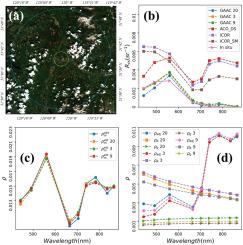求助PDF
{"title":"受邻接效应影响的水体大气校正遗传算法(GAAC)","authors":"Yanqun Pan, Simon Bélanger","doi":"10.1016/j.rse.2024.114508","DOIUrl":null,"url":null,"abstract":"Adjacency effect (AE) corrections over inland water surfaces has been a known issue in space-borne optical remote sensing over more than four decades. Here we present a novel algorithm able to simultaneously retrieve the aerosol optical depth, sun glint, AE, water reflectance, and water inherent optical properties (IOPs). The method was evaluated against an <em>in situ</em> data set of remote sensing reflectance (<span><span style=\"\"></span><span data-mathml='<math xmlns=\"http://www.w3.org/1998/Math/MathML\"><msub is=\"true\"><mrow is=\"true\"><mi is=\"true\">R</mi></mrow><mrow is=\"true\"><mi is=\"true\">r</mi><mi is=\"true\">s</mi></mrow></msub></math>' role=\"presentation\" style=\"font-size: 90%; display: inline-block; position: relative;\" tabindex=\"0\"><svg aria-hidden=\"true\" focusable=\"false\" height=\"2.317ex\" role=\"img\" style=\"vertical-align: -0.582ex;\" viewbox=\"0 -747.2 1510.7 997.6\" width=\"3.509ex\" xmlns:xlink=\"http://www.w3.org/1999/xlink\"><g fill=\"currentColor\" stroke=\"currentColor\" stroke-width=\"0\" transform=\"matrix(1 0 0 -1 0 0)\"><g is=\"true\"><g is=\"true\"><g is=\"true\"><use xlink:href=\"#MJMATHI-52\"></use></g></g><g is=\"true\" transform=\"translate(759,-150)\"><g is=\"true\"><use transform=\"scale(0.707)\" xlink:href=\"#MJMATHI-72\"></use></g><g is=\"true\" transform=\"translate(319,0)\"><use transform=\"scale(0.707)\" xlink:href=\"#MJMATHI-73\"></use></g></g></g></g></svg><span role=\"presentation\"><math xmlns=\"http://www.w3.org/1998/Math/MathML\"><msub is=\"true\"><mrow is=\"true\"><mi is=\"true\">R</mi></mrow><mrow is=\"true\"><mi is=\"true\">r</mi><mi is=\"true\">s</mi></mrow></msub></math></span></span><script type=\"math/mml\"><math><msub is=\"true\"><mrow is=\"true\"><mi is=\"true\">R</mi></mrow><mrow is=\"true\"><mi is=\"true\">r</mi><mi is=\"true\">s</mi></mrow></msub></math></script></span>) collected in <span><span style=\"\"></span><span data-mathml='<math xmlns=\"http://www.w3.org/1998/Math/MathML\"><mo is=\"true\">&#x223C;</mo></math>' role=\"presentation\" style=\"font-size: 90%; display: inline-block; position: relative;\" tabindex=\"0\"><svg aria-hidden=\"true\" focusable=\"false\" height=\"1.163ex\" role=\"img\" style=\"vertical-align: 0.307ex; margin-bottom: -0.427ex;\" viewbox=\"0 -449.1 778.5 500.8\" width=\"1.808ex\" xmlns:xlink=\"http://www.w3.org/1999/xlink\"><g fill=\"currentColor\" stroke=\"currentColor\" stroke-width=\"0\" transform=\"matrix(1 0 0 -1 0 0)\"><g is=\"true\"><use xlink:href=\"#MJMAIN-223C\"></use></g></g></svg><span role=\"presentation\"><math xmlns=\"http://www.w3.org/1998/Math/MathML\"><mo is=\"true\">∼</mo></math></span></span><script type=\"math/mml\"><math><mo is=\"true\">∼</mo></math></script></span>100 lakes across Canada. The new algorithm is based on a genetic optimization scheme (GAAC: Genetic Algorithm for Atmospheric Correction), and was here compared to the most popular atmospheric correction algorithms available (ACOLITE, iCOR+SIMEC). The statistical metrics of the <span><span style=\"\"></span><span data-mathml='<math xmlns=\"http://www.w3.org/1998/Math/MathML\"><msub is=\"true\"><mrow is=\"true\"><mi is=\"true\">R</mi></mrow><mrow is=\"true\"><mi is=\"true\">r</mi><mi is=\"true\">s</mi></mrow></msub></math>' role=\"presentation\" style=\"font-size: 90%; display: inline-block; position: relative;\" tabindex=\"0\"><svg aria-hidden=\"true\" focusable=\"false\" height=\"2.317ex\" role=\"img\" style=\"vertical-align: -0.582ex;\" viewbox=\"0 -747.2 1510.7 997.6\" width=\"3.509ex\" xmlns:xlink=\"http://www.w3.org/1999/xlink\"><g fill=\"currentColor\" stroke=\"currentColor\" stroke-width=\"0\" transform=\"matrix(1 0 0 -1 0 0)\"><g is=\"true\"><g is=\"true\"><g is=\"true\"><use xlink:href=\"#MJMATHI-52\"></use></g></g><g is=\"true\" transform=\"translate(759,-150)\"><g is=\"true\"><use transform=\"scale(0.707)\" xlink:href=\"#MJMATHI-72\"></use></g><g is=\"true\" transform=\"translate(319,0)\"><use transform=\"scale(0.707)\" xlink:href=\"#MJMATHI-73\"></use></g></g></g></g></svg><span role=\"presentation\"><math xmlns=\"http://www.w3.org/1998/Math/MathML\"><msub is=\"true\"><mrow is=\"true\"><mi is=\"true\">R</mi></mrow><mrow is=\"true\"><mi is=\"true\">r</mi><mi is=\"true\">s</mi></mrow></msub></math></span></span><script type=\"math/mml\"><math><msub is=\"true\"><mrow is=\"true\"><mi is=\"true\">R</mi></mrow><mrow is=\"true\"><mi is=\"true\">r</mi><mi is=\"true\">s</mi></mrow></msub></math></script></span> retrieval were improved by a factor of almost 2 in all wavelengths, and for all metrics (Bias, Error, Similarity Angle) relative to other algorithms. Demonstrations of GAAC on scenes of Lansdat-8 OLI, and Sentinel-2 MSI sensors demonstrate the algorithm’s robustness when applied to spatially complex small lake (<span><span style=\"\"></span><span data-mathml='<math xmlns=\"http://www.w3.org/1998/Math/MathML\"><mo is=\"true\">&#x223C;</mo></math>' role=\"presentation\" style=\"font-size: 90%; display: inline-block; position: relative;\" tabindex=\"0\"><svg aria-hidden=\"true\" focusable=\"false\" height=\"1.163ex\" role=\"img\" style=\"vertical-align: 0.307ex; margin-bottom: -0.427ex;\" viewbox=\"0 -449.1 778.5 500.8\" width=\"1.808ex\" xmlns:xlink=\"http://www.w3.org/1999/xlink\"><g fill=\"currentColor\" stroke=\"currentColor\" stroke-width=\"0\" transform=\"matrix(1 0 0 -1 0 0)\"><g is=\"true\"><use xlink:href=\"#MJMAIN-223C\"></use></g></g></svg><span role=\"presentation\"><math xmlns=\"http://www.w3.org/1998/Math/MathML\"><mo is=\"true\">∼</mo></math></span></span><script type=\"math/mml\"><math><mo is=\"true\">∼</mo></math></script></span>10 km of width) surfaces.","PeriodicalId":417,"journal":{"name":"Remote Sensing of Environment","volume":"19 1","pages":""},"PeriodicalIF":11.1000,"publicationDate":"2024-11-21","publicationTypes":"Journal Article","fieldsOfStudy":null,"isOpenAccess":false,"openAccessPdf":"","citationCount":"0","resultStr":"{\"title\":\"Genetic Algorithm for Atmospheric Correction (GAAC) of water bodies impacted by adjacency effects\",\"authors\":\"Yanqun Pan, Simon Bélanger\",\"doi\":\"10.1016/j.rse.2024.114508\",\"DOIUrl\":null,\"url\":null,\"abstract\":\"Adjacency effect (AE) corrections over inland water surfaces has been a known issue in space-borne optical remote sensing over more than four decades. Here we present a novel algorithm able to simultaneously retrieve the aerosol optical depth, sun glint, AE, water reflectance, and water inherent optical properties (IOPs). The method was evaluated against an <em>in situ</em> data set of remote sensing reflectance (<span><span style=\\\"\\\"></span><span data-mathml='<math xmlns=\\\"http://www.w3.org/1998/Math/MathML\\\"><msub is=\\\"true\\\"><mrow is=\\\"true\\\"><mi is=\\\"true\\\">R</mi></mrow><mrow is=\\\"true\\\"><mi is=\\\"true\\\">r</mi><mi is=\\\"true\\\">s</mi></mrow></msub></math>' role=\\\"presentation\\\" style=\\\"font-size: 90%; display: inline-block; position: relative;\\\" tabindex=\\\"0\\\"><svg aria-hidden=\\\"true\\\" focusable=\\\"false\\\" height=\\\"2.317ex\\\" role=\\\"img\\\" style=\\\"vertical-align: -0.582ex;\\\" viewbox=\\\"0 -747.2 1510.7 997.6\\\" width=\\\"3.509ex\\\" xmlns:xlink=\\\"http://www.w3.org/1999/xlink\\\"><g fill=\\\"currentColor\\\" stroke=\\\"currentColor\\\" stroke-width=\\\"0\\\" transform=\\\"matrix(1 0 0 -1 0 0)\\\"><g is=\\\"true\\\"><g is=\\\"true\\\"><g is=\\\"true\\\"><use xlink:href=\\\"#MJMATHI-52\\\"></use></g></g><g is=\\\"true\\\" transform=\\\"translate(759,-150)\\\"><g is=\\\"true\\\"><use transform=\\\"scale(0.707)\\\" xlink:href=\\\"#MJMATHI-72\\\"></use></g><g is=\\\"true\\\" transform=\\\"translate(319,0)\\\"><use transform=\\\"scale(0.707)\\\" xlink:href=\\\"#MJMATHI-73\\\"></use></g></g></g></g></svg><span role=\\\"presentation\\\"><math xmlns=\\\"http://www.w3.org/1998/Math/MathML\\\"><msub is=\\\"true\\\"><mrow is=\\\"true\\\"><mi is=\\\"true\\\">R</mi></mrow><mrow is=\\\"true\\\"><mi is=\\\"true\\\">r</mi><mi is=\\\"true\\\">s</mi></mrow></msub></math></span></span><script type=\\\"math/mml\\\"><math><msub is=\\\"true\\\"><mrow is=\\\"true\\\"><mi is=\\\"true\\\">R</mi></mrow><mrow is=\\\"true\\\"><mi is=\\\"true\\\">r</mi><mi is=\\\"true\\\">s</mi></mrow></msub></math></script></span>) collected in <span><span style=\\\"\\\"></span><span data-mathml='<math xmlns=\\\"http://www.w3.org/1998/Math/MathML\\\"><mo is=\\\"true\\\">&#x223C;</mo></math>' role=\\\"presentation\\\" style=\\\"font-size: 90%; display: inline-block; position: relative;\\\" tabindex=\\\"0\\\"><svg aria-hidden=\\\"true\\\" focusable=\\\"false\\\" height=\\\"1.163ex\\\" role=\\\"img\\\" style=\\\"vertical-align: 0.307ex; margin-bottom: -0.427ex;\\\" viewbox=\\\"0 -449.1 778.5 500.8\\\" width=\\\"1.808ex\\\" xmlns:xlink=\\\"http://www.w3.org/1999/xlink\\\"><g fill=\\\"currentColor\\\" stroke=\\\"currentColor\\\" stroke-width=\\\"0\\\" transform=\\\"matrix(1 0 0 -1 0 0)\\\"><g is=\\\"true\\\"><use xlink:href=\\\"#MJMAIN-223C\\\"></use></g></g></svg><span role=\\\"presentation\\\"><math xmlns=\\\"http://www.w3.org/1998/Math/MathML\\\"><mo is=\\\"true\\\">∼</mo></math></span></span><script type=\\\"math/mml\\\"><math><mo is=\\\"true\\\">∼</mo></math></script></span>100 lakes across Canada. The new algorithm is based on a genetic optimization scheme (GAAC: Genetic Algorithm for Atmospheric Correction), and was here compared to the most popular atmospheric correction algorithms available (ACOLITE, iCOR+SIMEC). The statistical metrics of the <span><span style=\\\"\\\"></span><span data-mathml='<math xmlns=\\\"http://www.w3.org/1998/Math/MathML\\\"><msub is=\\\"true\\\"><mrow is=\\\"true\\\"><mi is=\\\"true\\\">R</mi></mrow><mrow is=\\\"true\\\"><mi is=\\\"true\\\">r</mi><mi is=\\\"true\\\">s</mi></mrow></msub></math>' role=\\\"presentation\\\" style=\\\"font-size: 90%; display: inline-block; position: relative;\\\" tabindex=\\\"0\\\"><svg aria-hidden=\\\"true\\\" focusable=\\\"false\\\" height=\\\"2.317ex\\\" role=\\\"img\\\" style=\\\"vertical-align: -0.582ex;\\\" viewbox=\\\"0 -747.2 1510.7 997.6\\\" width=\\\"3.509ex\\\" xmlns:xlink=\\\"http://www.w3.org/1999/xlink\\\"><g fill=\\\"currentColor\\\" stroke=\\\"currentColor\\\" stroke-width=\\\"0\\\" transform=\\\"matrix(1 0 0 -1 0 0)\\\"><g is=\\\"true\\\"><g is=\\\"true\\\"><g is=\\\"true\\\"><use xlink:href=\\\"#MJMATHI-52\\\"></use></g></g><g is=\\\"true\\\" transform=\\\"translate(759,-150)\\\"><g is=\\\"true\\\"><use transform=\\\"scale(0.707)\\\" xlink:href=\\\"#MJMATHI-72\\\"></use></g><g is=\\\"true\\\" transform=\\\"translate(319,0)\\\"><use transform=\\\"scale(0.707)\\\" xlink:href=\\\"#MJMATHI-73\\\"></use></g></g></g></g></svg><span role=\\\"presentation\\\"><math xmlns=\\\"http://www.w3.org/1998/Math/MathML\\\"><msub is=\\\"true\\\"><mrow is=\\\"true\\\"><mi is=\\\"true\\\">R</mi></mrow><mrow is=\\\"true\\\"><mi is=\\\"true\\\">r</mi><mi is=\\\"true\\\">s</mi></mrow></msub></math></span></span><script type=\\\"math/mml\\\"><math><msub is=\\\"true\\\"><mrow is=\\\"true\\\"><mi is=\\\"true\\\">R</mi></mrow><mrow is=\\\"true\\\"><mi is=\\\"true\\\">r</mi><mi is=\\\"true\\\">s</mi></mrow></msub></math></script></span> retrieval were improved by a factor of almost 2 in all wavelengths, and for all metrics (Bias, Error, Similarity Angle) relative to other algorithms. Demonstrations of GAAC on scenes of Lansdat-8 OLI, and Sentinel-2 MSI sensors demonstrate the algorithm’s robustness when applied to spatially complex small lake (<span><span style=\\\"\\\"></span><span data-mathml='<math xmlns=\\\"http://www.w3.org/1998/Math/MathML\\\"><mo is=\\\"true\\\">&#x223C;</mo></math>' role=\\\"presentation\\\" style=\\\"font-size: 90%; display: inline-block; position: relative;\\\" tabindex=\\\"0\\\"><svg aria-hidden=\\\"true\\\" focusable=\\\"false\\\" height=\\\"1.163ex\\\" role=\\\"img\\\" style=\\\"vertical-align: 0.307ex; margin-bottom: -0.427ex;\\\" viewbox=\\\"0 -449.1 778.5 500.8\\\" width=\\\"1.808ex\\\" xmlns:xlink=\\\"http://www.w3.org/1999/xlink\\\"><g fill=\\\"currentColor\\\" stroke=\\\"currentColor\\\" stroke-width=\\\"0\\\" transform=\\\"matrix(1 0 0 -1 0 0)\\\"><g is=\\\"true\\\"><use xlink:href=\\\"#MJMAIN-223C\\\"></use></g></g></svg><span role=\\\"presentation\\\"><math xmlns=\\\"http://www.w3.org/1998/Math/MathML\\\"><mo is=\\\"true\\\">∼</mo></math></span></span><script type=\\\"math/mml\\\"><math><mo is=\\\"true\\\">∼</mo></math></script></span>10 km of width) surfaces.\",\"PeriodicalId\":417,\"journal\":{\"name\":\"Remote Sensing of Environment\",\"volume\":\"19 1\",\"pages\":\"\"},\"PeriodicalIF\":11.1000,\"publicationDate\":\"2024-11-21\",\"publicationTypes\":\"Journal Article\",\"fieldsOfStudy\":null,\"isOpenAccess\":false,\"openAccessPdf\":\"\",\"citationCount\":\"0\",\"resultStr\":null,\"platform\":\"Semanticscholar\",\"paperid\":null,\"PeriodicalName\":\"Remote Sensing of Environment\",\"FirstCategoryId\":\"5\",\"ListUrlMain\":\"https://doi.org/10.1016/j.rse.2024.114508\",\"RegionNum\":1,\"RegionCategory\":\"地球科学\",\"ArticlePicture\":[],\"TitleCN\":null,\"AbstractTextCN\":null,\"PMCID\":null,\"EPubDate\":\"\",\"PubModel\":\"\",\"JCR\":\"Q1\",\"JCRName\":\"ENVIRONMENTAL SCIENCES\",\"Score\":null,\"Total\":0}","platform":"Semanticscholar","paperid":null,"PeriodicalName":"Remote Sensing of Environment","FirstCategoryId":"5","ListUrlMain":"https://doi.org/10.1016/j.rse.2024.114508","RegionNum":1,"RegionCategory":"地球科学","ArticlePicture":[],"TitleCN":null,"AbstractTextCN":null,"PMCID":null,"EPubDate":"","PubModel":"","JCR":"Q1","JCRName":"ENVIRONMENTAL SCIENCES","Score":null,"Total":0}
引用次数: 0
引用
批量引用
Genetic Algorithm for Atmospheric Correction (GAAC) of water bodies impacted by adjacency effects
Adjacency effect (AE) corrections over inland water surfaces has been a known issue in space-borne optical remote sensing over more than four decades. Here we present a novel algorithm able to simultaneously retrieve the aerosol optical depth, sun glint, AE, water reflectance, and water inherent optical properties (IOPs). The method was evaluated against an in situ data set of remote sensing reflectance (R r s ∼ R r s ∼



